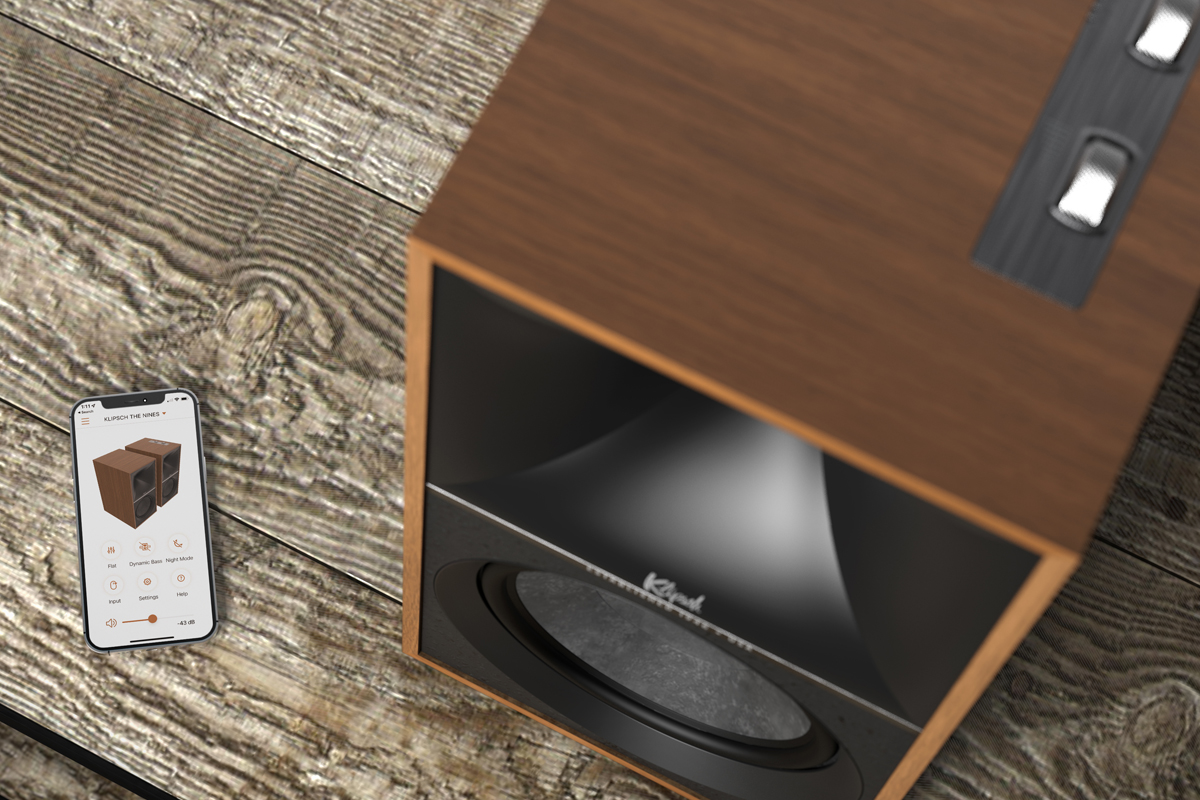I think marketing geniuses can sometimes be too smart for the good of the companies they’re trying to promote. Consider the slogan that Klipsch Audio Technologies came up with in 2021 to celebrate the brand’s 75th anniversary: “Pissing off the neighbors since 1946.” The company even created a “Pissing Off the Neighbors” edition of its RB-81 MkII bookshelf loudspeaker (now discontinued).
I don’t know what that slogan says to you, but to me it says: “We’re not afraid to be obnoxious—we take pride in it. Our speakers can play real loud, and that’s all we care about. Timbral accuracy, low distortion, smoothness, imaging, and soundstaging—who gives a f**k about that audiophile BS?”
In fact, Klipsch cares a great deal about that stuff, and the top model in its lineup of active loudspeakers proves it. Priced at $1499 per system (all prices in USD unless noted), The Nines has an 8″ midrange-woofer with a fiber-composite cone and a horn-loaded 1″ titanium-dome tweeter in each enclosure—the same driver complement as the RB-81 MkII. For $1899, you can get a special McLaren edition of The Nines, with the same racing theme as the POTN edition of the RB-81 MkII.
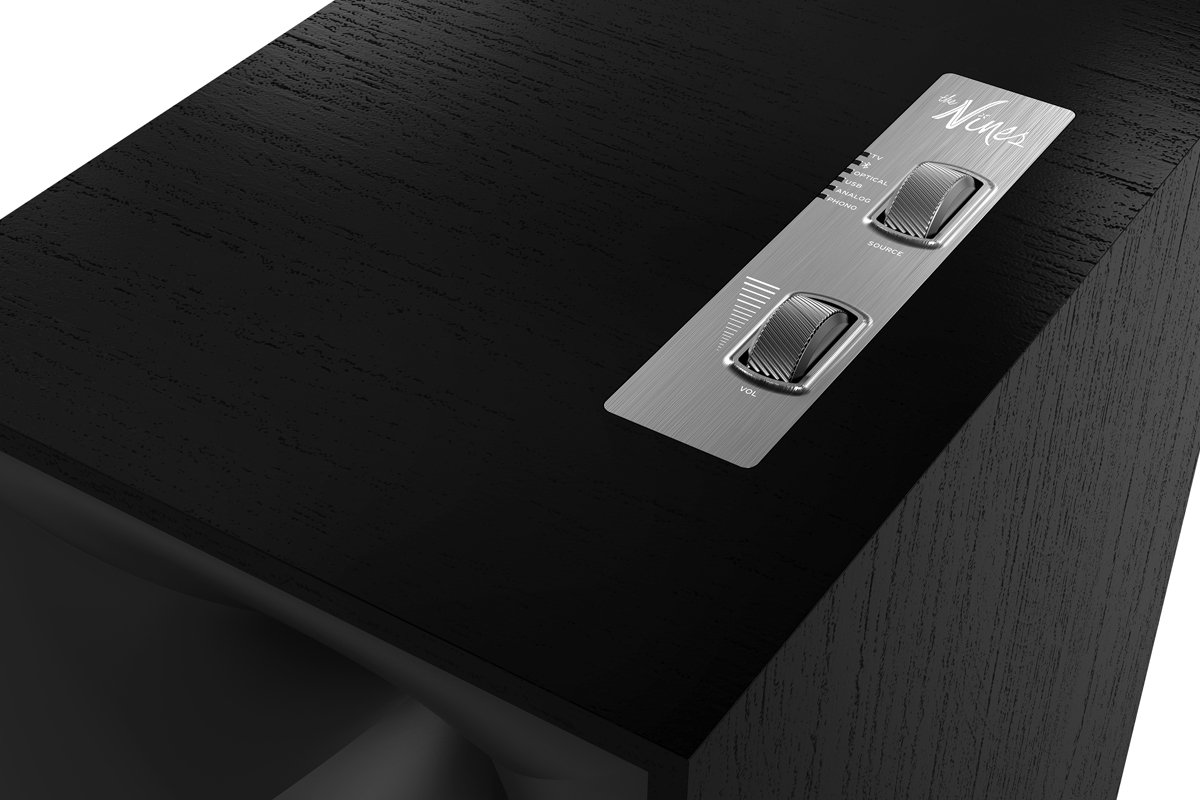
But the similarities end there. The enclosure, midrange-woofer, and horn designs of The Nines are quite different from the passive RB-81 MkII. And most importantly, The Nines is a fully self-contained sound system with built-in amplification and an ample range of inputs—just add source components and play some music. And (spoiler alert), this system does more than just play loudly. I found The Nines very enjoyable to listen to.
Inside and out
Although Klipsch calls The Nines “powered speakers,” it is an active system, with dedicated amplifiers for each driver and a DSP-enabled crossover that comes before the amplifiers in the signal path. As noted, each enclosure houses an 8″ high-excursion midrange-woofer with fiber-composite cone and a 1″ titanium horn-loaded tweeter. Each midrange-woofer is powered by an amplifier specified to output 100W, and each tweeter by an amplifier rated at 20W. Specified frequency response is 34Hz–25kHz, ±3dB.
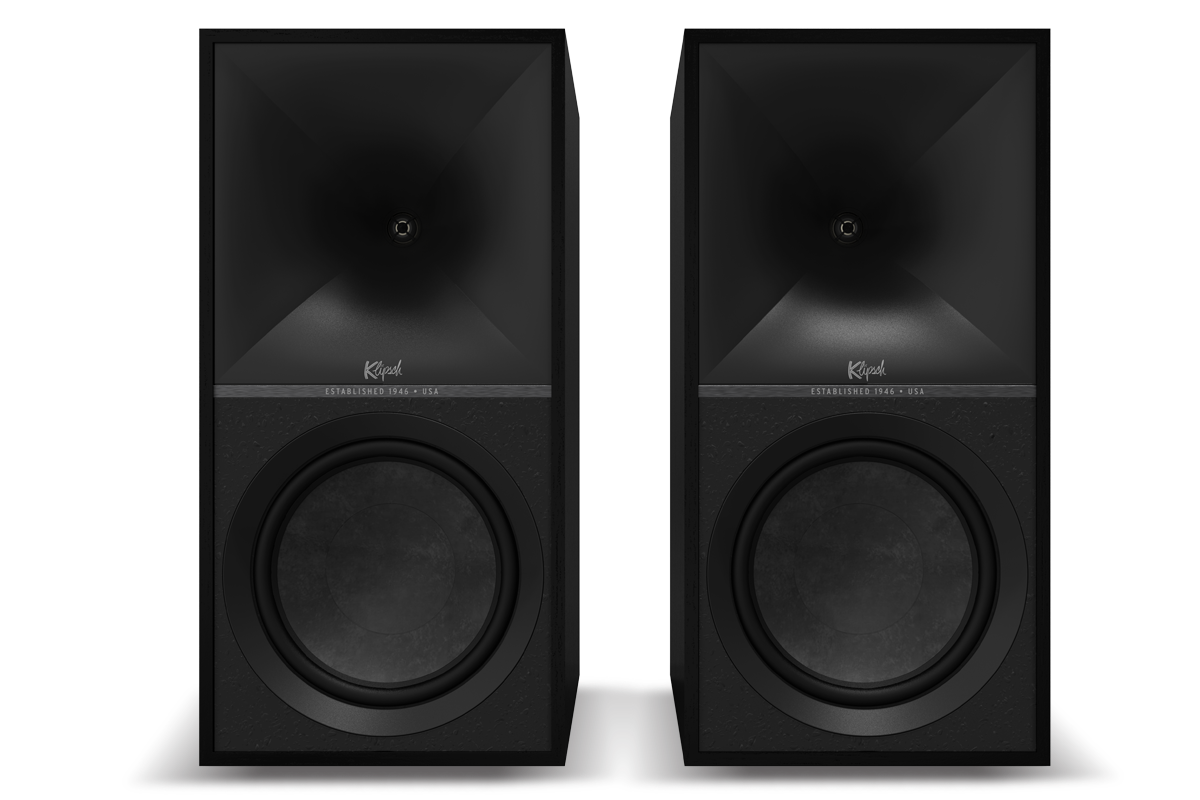
The amplifiers and other electronics are housed in the primary speaker, which connects to the secondary speaker via a four-conductor cable that carries separate signals for the midrange-woofer and tweeter. Klipsch supplies a 4m (13′) umbilical cable with The Nines, plus a 2m (6.5′) extension cable for users who need to place the speakers farther apart.
The Nines has Klipsch’s signature retro styling, which—with characteristic modesty—the company calls “mid-century magnificent.” The 1970s aesthetic is best suited for rooms with a casual décor. Two standard finishes are available: the Walnut version comes with magnetically attached, woven-cloth grilles in a cream color, while the Black version has dark-gray grilles. My review sample had the Black finish, and it looked kind of industrial in our living room, especially with the grilles removed. Based on photos, I find the Walnut finish more attractive.
The rectilinear enclosures are constructed from 3/8″ MDF and finished with genuine wood veneer. Given the thickness of the cabinet walls, I wasn’t surprised to hear a hollow thunk when I performed the knuckle test. But I heard no obvious cabinet resonances during my listening. When I put my hand on one of the enclosures, while playing music with ample bass content at high volumes, I felt only very mild vibrations.
Each grille has a small badge with the Klipsch logo in the lower-right corner. Removing the grille reveals the 8″ midrange-woofer filling most of the bottom half of the baffle, and the large, deep horn for the tweeter occupying the entire upper half. The Klipsch logo is also emblazoned on the lower edge of the horn. Especially with the grilles removed, The Nines looks quite imposing—not surprising, given that each speaker measures 19.1″H × 9.5″W × 13.4″D. The primary speaker weighs 28.4 pounds, and the secondary speaker weighs 27 pounds.
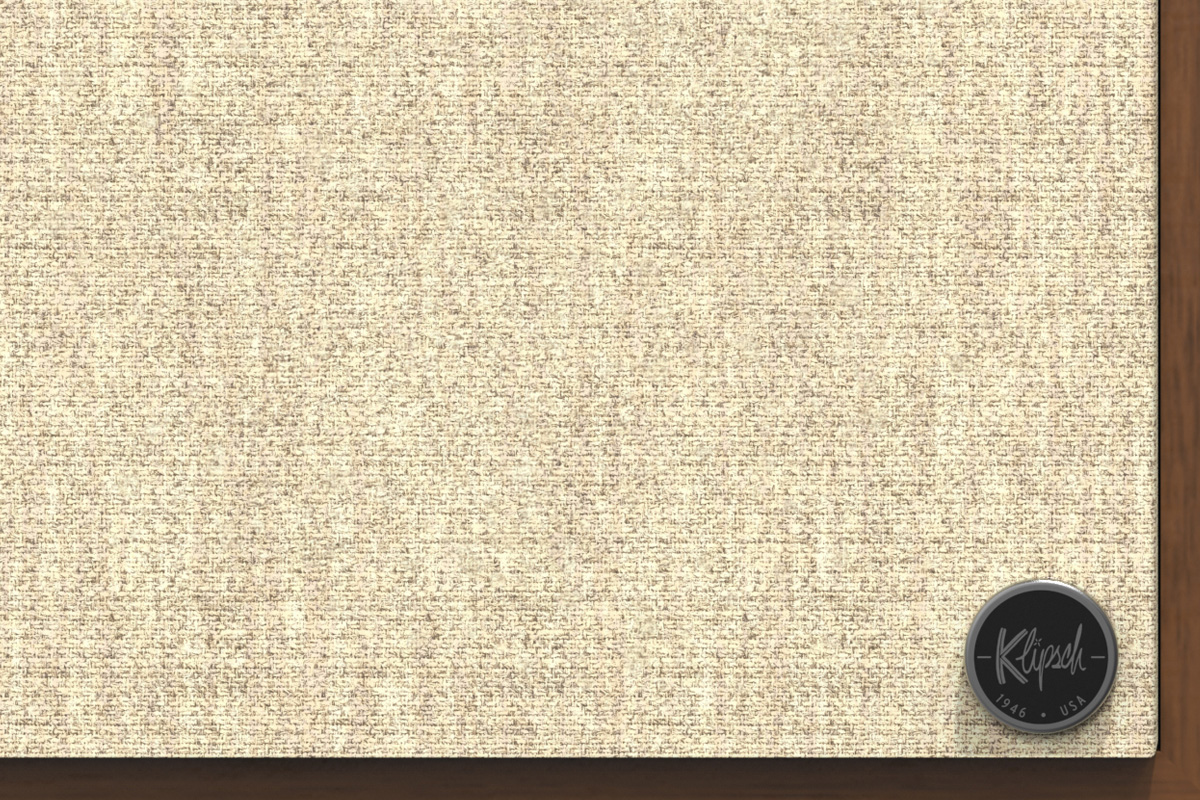
There’s not much to see on the back of the secondary speaker: just a terminal for the umbilical cable in the bottom center, and at the top, a bass port with a horn-like vent. That same vent is present on the back of the primary speaker. Below the vent is the connection panel, where you’ll find an HDMI ARC input for connection to a TV, a Bluetooth pairing button, a pair of RCA inputs that can be set for phono or line-level operation, a 3.5mm stereo line-level input, an RCA subwoofer output jack, an optical S/PDIF (TosLink) input, and a USB audio input for connection to a computer or streamer. Usefully, there’s a switch for setting the primary speaker to play left- or right-channel audio. This feature, weirdly missing on some active and powered speaker systems, makes it easier to place the primary speaker near your source components. On the bottom row is a four-conductor connector for the cable that sends audio to the secondary speaker, and the power switch, voltage selector, and three-prong IEC power inlet.
On the top panel of the primary speaker are two thumbwheel controllers: one for setting volume, the other for cycling through sources. These controls have a nice, silky feel, and add to the system’s retro vibe. LEDs next to the source control show the selected source, but as with many powered and active speakers, there’s no visible indication of the volume setting. Klipsch also supplies a small, plastic remote control with power on/off, volume up/down, mute, play/pause, subwoofer level, and source-selection functions. Other supplied accessories include a 2m power cable, 1.5m HDMI cable, and 1.5m USB A-to-B cable
In addition to implementing the active crossover, the digital processor in the primary speaker enables a loudness-correction feature Klipsch calls “Dynamic Bass EQ.” This increases bass output at low volume settings. Dynamic Bass EQ can be toggled by pressing the Subwoofer Reset control on the remote control for three seconds. I found that the amount of LF boost was well judged: at high volume levels it did not boost the bass at all, and a welcome fullness to the sound was added at low volume settings.
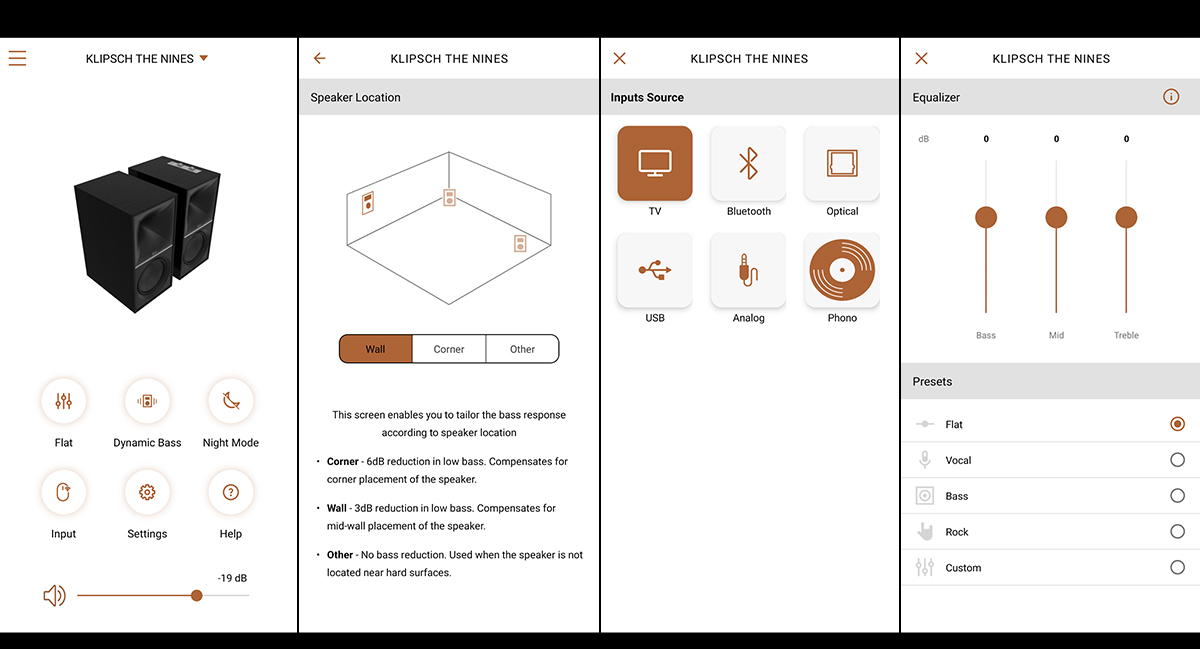
You can also control The Nines with the Klipsch Connect app, which is available for Android and iOS. The app communicates with the speaker system via Bluetooth, and guides you through initial setup of The Nines the first time you use it. During day-to-day use, the app takes a few seconds to connect to the system after you fire it up, but it’s worth the wait. The app provides all the functions available from the remote (volume, power, mute, sub level, source selection, Dynamic Bass EQ), plus a couple of others. There’s a three-band tone control for adjusting bass, midrange, and treble. There’s also a Speaker Placement function with three options: Wall, Corner, and Other. The Wall and Corner settings respectively provide 3dB and 6dB of bass attenuation. Finally, there’s a Night Mode option that reduces bass output significantly so that users don’t “piss off” housemates or neighbors during late-night listening sessions.
Setup and listening
I placed The Nines on 28″ sand-filled speaker stands on either side of the electric fireplace in my living room. The speakers were 12″ from the front wall, 7′ apart, and 7′ from my listening position on the end cushion of the sectional sofa on the opposite wall. I experimented with Speaker Placement options in the Klipsch Connect app and found that the Wall setting provided the best balance between bass output and bass definition. I left the EQ controls in their flat position and Dynamic EQ off.
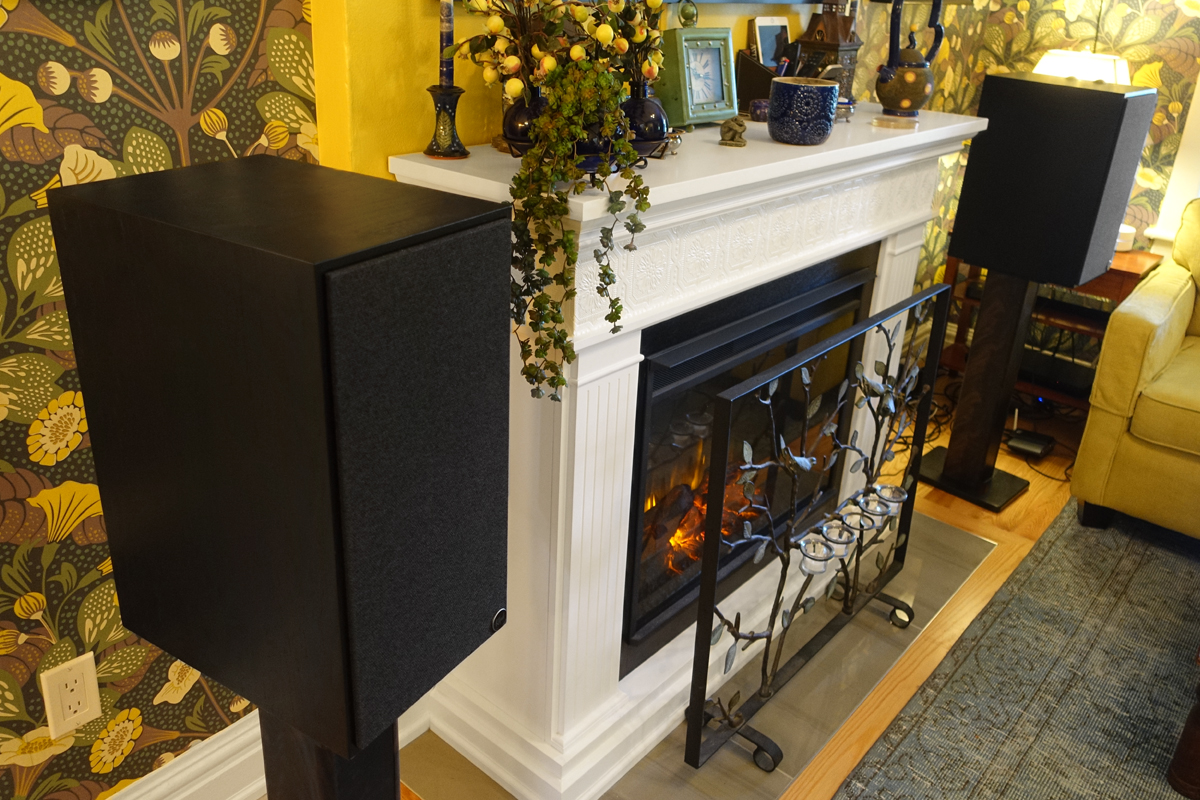
For my testing, I used three sources: an iFi Audio Zen Stream streamer ($399), which I connected to the USB input; my Pro-Ject Debut Carbon Evo turntable ($869 CAD with Ortofon 2M Red cartridge), which I connected to the RCA inputs; and the breakout box for my 55″ Samsung Frame TV, which I connected to the HDMI ARC input.
Looking at these speakers and knowing who makes them, you’d expect The Nines to deliver big, room-filling sound and deep bass extension. And that is exactly what I heard when I played one of my go-to tracks: Thelonius Monk’s “Blue Monk,” from the Chick Corea Trio’s live concert compilation Trilogy (24-bit/96kHz FLAC, Concord Jazz / ProStudioMasters). Through The Nines, Christian McBride’s double bass sounded full and robust, and also taut and tuneful—except for a bit of bloat in the lowest notes. But I’m inclined to attribute the bloat to my listening room, which has some nasty standing waves. I was even more impressed by the fluidity and ease of delivery of The Nines. Notes and chords from Corea’s piano flowed from the left side of the soundstage with disarming ease and naturalness; and Brian Blade’s deft snare rolls had lovely texture. However, highs were a tad soft-edged, so that Blade’s rim shots, Corea’s staccato notes, and the leading edges of McBride’s double-bass notes had slightly less snap than I would have liked. While side-to-side imaging was very good, the soundstage didn’t have much depth—everything was on the same plane as the speakers. But all in all, this was a very promising beginning.
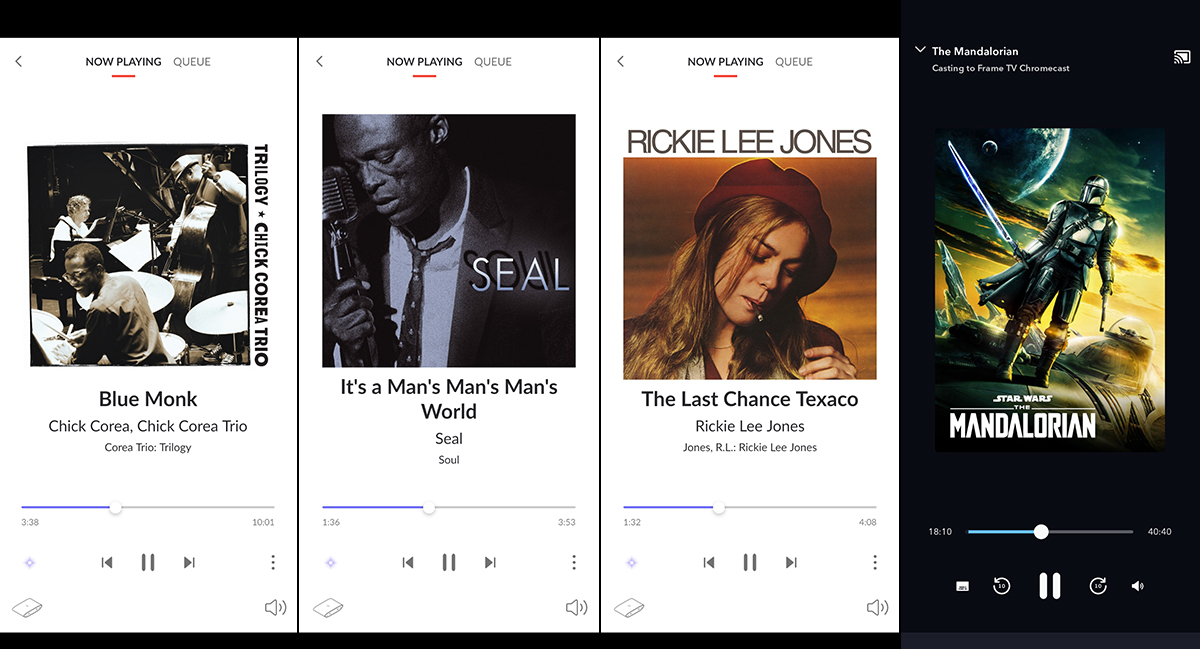
I also noticed slightly rolled-off highs on Seal’s version of James Brown’s “It’s a Man’s Man’s Man’s World” from Soul (16/44.1 FLAC, Warner Bros. Records / Qobuz), Seal’s 2008 set of covers of Motown hits of the ’60s and ’70s. High notes played by the violins and trumpets in David Foster’s lush orchestral arrangement sounded a little truncated. As a result, those notes had a slightly steely edge, especially when played loudly. But in their middle and lower ranges, the strings were rich and resonant. Except for a very mild nasal coloration in the middle part of his vocal range, Seal’s impassioned singing sounded completely natural. The Klipsch speakers scaled up effortlessly to track his expressive dynamics, and the electric bass and electronic drums hit impressively hard. As with the Corea recording, the soundstage was confined to the speaker plane.
My admiration for the dynamic capabilities of The Nines continued with “The Last Chance Texaco,” from Rickie Lee Jones’s self-titled debut album (16/44.1 FLAC, Warner Bros. Records). When Jones’s voice soared to express the desperate longing (“It’s her last chance / Her timing’s all wrong”), the Klipsch system kept pace easily, reproducing her expressive soprano with no hint of strain. But what really blew me away was how The Nines handled subtler expressive details. Through The Nines, I heard every nuance in Jones’s delivery when she lowers her voice to a whisper to sing “a slow and easy mark.” And the Klipsch system clearly conveyed the way Jones forms her consonants, without exaggerating the effect. The metallic ring and woody decay of two steel-strung acoustic guitars on either side of the soundstage were convincingly real. As with the other selections, The Nines provided good side-to-side imaging, but little sense of soundstage depth.
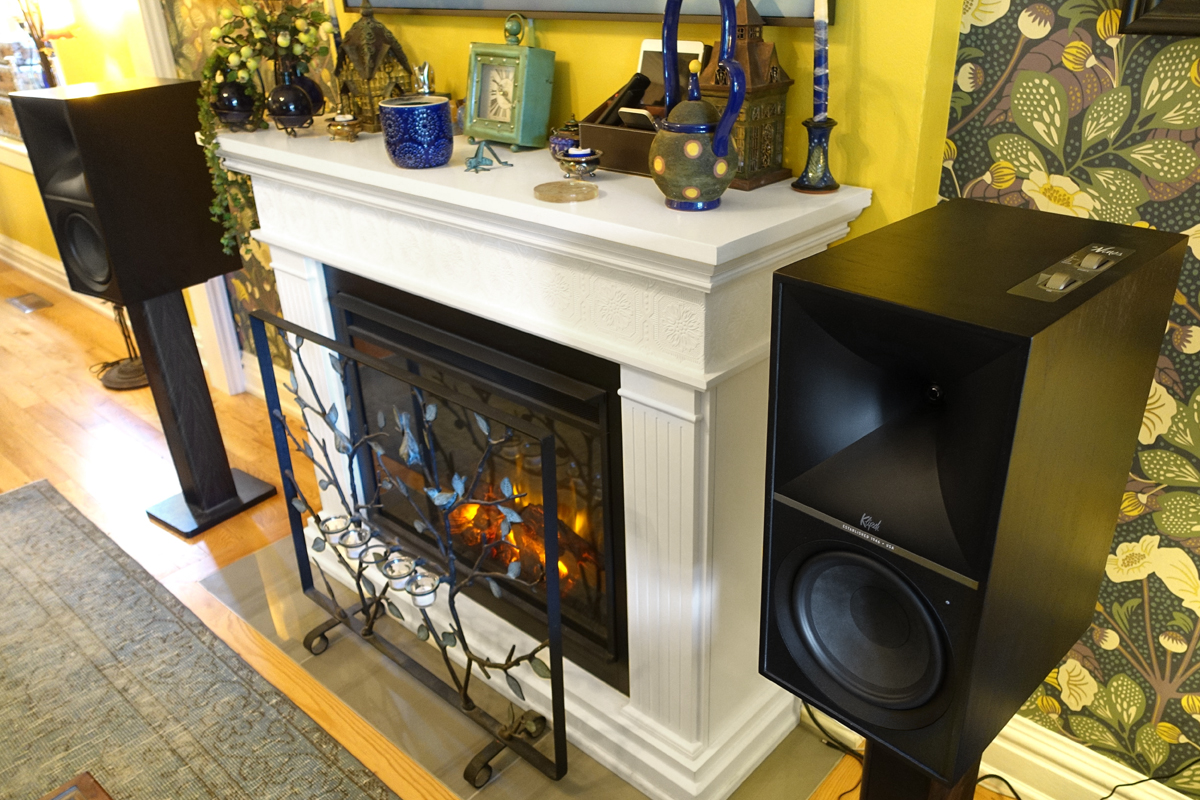
Time to spin some vinyl. I could hear mild hiss and hum from 4′ away at moderately loud levels with no music playing, but they were barely audible from my listening position, and completely inaudible when music was playing.
On her 2022 EP Live from Studio S2 Warsaw (Gondwana Records GONDEP048), the Polish keyboardist, composer, and singer Hania Rani plays an open upright piano, Steinway grand, Roland stage piano, and Prophet ’08 synth, and also sings on one track. As with my other selections, the soundstage was confined to the area between between the speakers on “Leaving,” but otherwise I loved how The Nines reproduced this track. The leading edges of notes on the open upright piano and looped Roland were clear but not overdone. I was grabbed by the way the Klipsch system captured the warm, muted character of the old upright. When Rani pivots to the Steinway, The Nines delivered higher notes with lovely ringing clarity and lower notes with fabulous authority. I particularly enjoyed the way the speaker system rendered Rani’s voice. It caught the breathy quality without exaggeration and tracked her expressive dynamic shading beautifully. Again, I was wowed by the fluidity and ease of delivery of The Nines. Dynamics were marvelous; whenever Rani hits a note hard on any of the keyboards, The Nines scaled up to deliver the notes with no sense of strain or compression.

As impressive as The Nines was with music, the speaker system was even more compelling with movies and video, as I confirmed by streaming the first episode of The Mandalorian from Disney+. The powerful sound effects and music soundtrack in this Star Wars spinoff exploded into my living room without a hint of compression or distress. The timpani and bass drums in the soundtrack were delivered with immense power. So were the sound effects, like the gunshots and explosions during the firefight in a desert compound where the quarry of the bounty-hunting Mandalorian is hidden. Would a full-blown, subwoofer-equipped surround system have delivered a more visceral, more immersive experience? Of course. Did this thought occur to me while I was watching the episode and hearing the soundtrack through The Nines? Not for a second.
Comparison
I compared The Nines with a similarly priced active speaker system: Q Acoustics’ Q Active 200 ($1999), which connects to sources via a wireless hub with phono, HDMI ARC, and optical S/PDIF inputs. The Q Active system also features built-in Wi-Fi and a Roon Ready streamer with support for Apple AirPlay 2, Spotify Connect, and Chromecast. If you add a Zen Stream or similar source to The Nines, the prices and capabilities of the two setups are very similar.
But these two systems have very different designs. Each Q Active 200 enclosure houses a rear-firing, 4.5″ bass driver powered by a 55W class-D amp and two front-firing 2.25″ balanced-mode radiator drivers, each powered by a 20W class-D amplifier. And the enclosure is much smaller—about one-third of the cabinet volume of the corresponding enclosure of The Nines. So, not surprisingly, these systems sounded quite different.
On Seal’s rendition of “It’s a Man’s Man’s Man’s World,” the Q Active system threw a wider, deeper soundstage, with better imaging specificity and front-to-back layering. There was a more transparent presentation of the orchestral accompaniment; high violin notes were more extended on the Q Active, but lower notes played by the strings were less full and lush. I did not notice the slightly nasal quality of Seal’s voice that I had heard with The Nines. But his voice sounded fuller and more embodied through The Nines, which scaled up and down readily to track Seal’s dynamic shading. Transient attacks on the electric bass and drums were faster and more dramatic through the Q Active system, but those instruments sounded bigger and more powerful through the Klipsch system. Played loudly, the Q Active sounded more strained and dynamically compressed than The Nines did at similar levels.
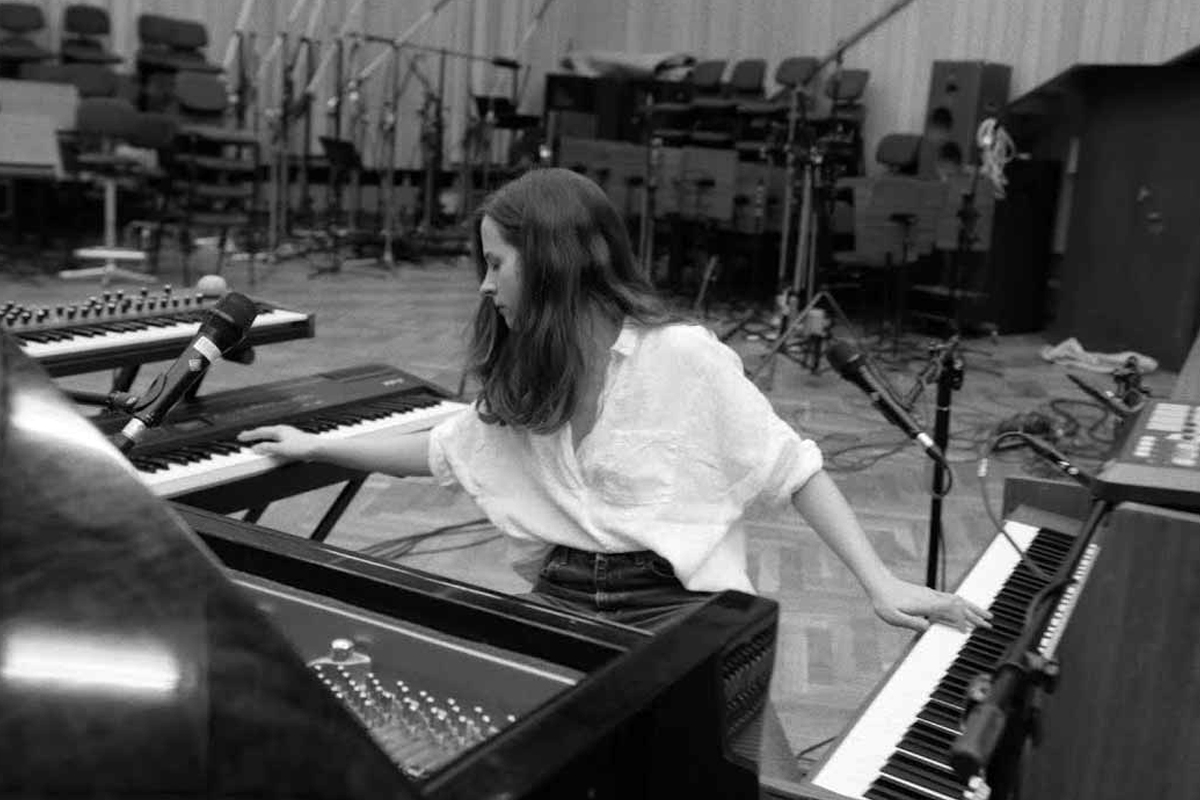
On “Leaving” by Hania Rani, the Q Active system created a vaster soundstage, with more precise locations of aural images. I had a much better sense of the Warsaw studio where this recording was made with the Q Active system. The leading edges of notes were faster, making it easier to appreciate Rani’s touch on the keyboards. Low notes on the Steinway had less authority on the Q Active, so that the size of the instrument was less apparent; loud notes in the higher registers sounded harder. With the synth, the low notes were less powerful through the Q Active than through the larger Klipsch system, but also less textured. The breathy quality of Rani’s voice seemed a touch exaggerated on the Q Active system, so that her voice sounded slightly brittle at times—The Nines tracked Rani’s vocal shading more convincingly.
Conclusion
By now, it should be clear that The Nines can do much more than just piss off the neighbors. This system can certainly play loudly when you want. But you will have to push it very hard before it begins to sound ugly—that never happened during my testing. Instead, what I consistently heard was smooth, fluid sound with gobs of dynamic expression. The Nines always invited me to keep on listening.
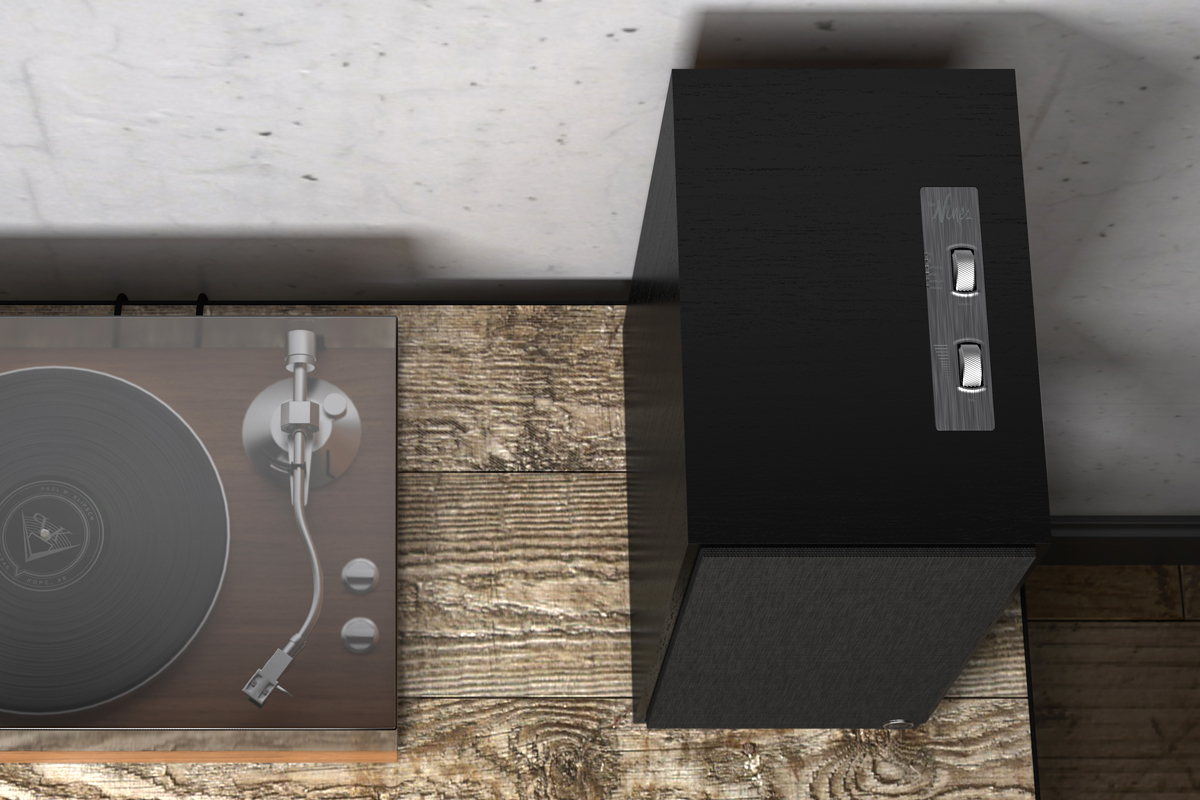
And the active design makes The Nines a very good deal. For $1499, you’re getting a fine set of speakers, 120Wpc of built-in amplification, a comprehensive range of inputs, and useful hardware controls. Combine that with Klipsch’s signature heritage styling, which has legions of fans, and you have a winner.
. . . Gordon Brockhouse
Associated Equipment
- Active loudspeaker system: Q Acoustics Q Active 200.
- Streamer: iFi Audio Zen Stream.
- Turntable: Pro-Ject Audio Systems Debut Carbon Evo with Ortofon 2M Red cartridge.
- Television: Samsung UN55LS003 55″ UHD TV “The Frame.”
- Network: Google Wifi four-node mesh network.
Klipsch The Nines Active Loudspeaker System
Price: $1499.
Warranty: One year, parts and labor.
Klipsch Ltd.
3502 Woodview Trace, Suite 200
Indianapolis, IN 46268
Phone: (317) 860-8100, (800) 544-1482
Website: www.klipsch.com
Canadian distributor:
Gentec International
90 Royal Crest Ct.
Markham, ON L3R 9X6
Website: www.gentec-intl.com



